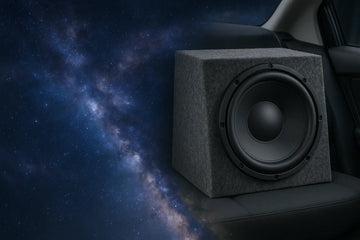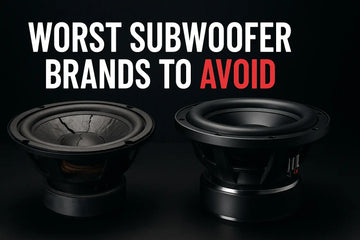In audio systems, subwoofers are crucial in delivering deep, powerful bass. But have you ever wondered how subwoofers can produce such low frequencies? The answer lies in an electrical property known as impedance, which many audio enthusiasts often overlook.
Understanding subwoofer impedance is essential for optimizing sound quality, ensuring proper power output, and avoiding potential damage to your equipment. This blog will delve into the basics of subwoofer impedance, its role in audio systems, wiring techniques, and much more.
Elevate your sound experience with a comprehensive understanding of subwoofer impedance. Uncover the key to optimizing your audio system, troubleshooting effectively, and achieving audio excellence.
What is Subwoofer Impedance?
Before diving into the specifics of subwoofer impedance, let's first understand what impedance means. In simple terms, impedance refers to the electrical resistance a subwoofer presents to the amplifier. It is typically measured in ohms and determines the current flow through the subwoofer. Subwoofer impedance can significantly impact the power delivered from the amplifier and the system's overall sound quality and bass response.
Defining Subwoofer Impedance
Defining subwoofer impedance involves understanding the electrical resistance the subwoofer presents to the amplifier. Measured in ohms, impedance dictates the current flow through the subwoofer and determines its opposition to the amplifier. Lower impedance subwoofers draw much current from the amplifier, resulting in higher sound output. The nominal impedance specifies the load impedance the amplifier should handle, making it crucial for selecting compatible amplifiers and wiring configurations.
The Role of Subwoofer Impedance in Audio Systems
Efficient power transfer depends on matching subwoofer impedance with the amplifier, impacting overall sound quality and distortion levels. Different frequencies require varying impedance levels to maintain proper frequency response. Knowledge of subwoofer impedance guides the creation of speaker systems for optimal performance. Subwoofer impedance affects the power delivered by the amplifier, necessitating an understanding of the amount of opposition in real-world audio systems.
Basics of Wiring Subwoofers
Wiring subwoofers connect the voice coil's positive terminal to the amp's positive terminal and the negative terminal to the negative terminal. When multiple subs are used, calculate the total impedance. Ensure that the speaker wire can handle the amount of current produced. A single voice coil sub offers simplicity, while a dual one provides more wiring configurations. Understanding the RMS ratings, rated impedance, and real-world application is crucial for proper amplification without overpowering the subwoofers.
Steps to Properly Wire Your Subwoofers
To ensure proper wiring of your subwoofers, understand their specifications to determine the wiring configuration. Series wiring adds the impedance, while parallel wiring reduces it, impacting the overall impedance. Correct wiring according to impedance ratings prevents amplifier damage and ensures each subwoofer receives the right power for balanced bass output. This knowledge optimizes the impedance for the desired sound without compromising the amplifier's integrity.
The Importance of Correct Wiring for Powerful Bass
Maximizing subwoofer impedance for efficient amplifier power usage is crucial. Mismatched impedance due to incorrect wiring can negatively impact bass output and amplifier performance. Understanding wiring basics ensures subwoofers receive proper power for impactful bass, while improper configurations can produce suboptimal sound quality and lower bass response. Proper wiring maintains amplifier stability, protects against electrical issues, and optimizes the subwoofers' performance.
Understand the Difference Between Resistance and Impedance
Resistance and impedance are often used interchangeably, but they have distinct meanings in audio systems and subwoofers. At the same time, resistance refers to the opposition to the flow of electrical current; impedance accounts for both resistance and reactance. In the real world, impedance affects how much current a subwoofer can draw from an amplifier. Understanding these terms' differences is crucial when determining the right speaker wire to use and the amount of opposition a subwoofer presents to an amplifier.
Explanation of Resistance and Impedance
The opposition to electrical current flow is measured in ohms and results in power dissipation as heat. When considering impedance, it considers resistance and the reactive elements present in the circuit. Unlike resistance, which remains constant, impedance fluctuates with frequency due to reactance effects. This understanding is crucial for designing subwoofer circuits to ensure optimal performance. Additionally, impedance considers resistance and the phase relationship between voltage and current.
The Impact of Resistance and Impedance on Audio Quality
The efficiency of power transfer and overall sound quality are impacted by resistance and impedance. Lower impedance subwoofers draw more current, leading to higher sound output but potentially straining the amplifier. Conversely, high-impedance subwoofers require less power from the amplifier, affecting bass response. In addition, impedance variations across frequencies can influence the frequency response of subwoofers. They recognize the impact of resistance and impedance guides in selecting subwoofer components for improved audio quality.
Amplifier Requirements Based on Speaker Impedance
When choosing an amplifier for a subwoofer, the voice coil configuration and the number of subs must be considered. Different configurations affect the amount of opposition to the current flow. Real-world speaker wire has a little bit of resistance, and the lowest impedance the amp can handle should match the rated impedance of the subs. The amp's RMS rating should also be considered, as it determines how much current the amp can provide to the sub.
How to Match Amplifiers with Different Impedance Levels
Ensuring efficient power output involves matching amplifier impedance levels and optimizing power transfer. Mismatched impedance can lead to power loss and distortion, affecting current flow and power output. Lower speaker system impedance requires higher current flow from the amplifier for maximum performance. It's crucial to consider impedance when connecting amplifiers and speakers to avoid inefficiencies and potential damage. This matching process enhances power transfer and prevents loss, benefiting the audio system.
Consequences of Mismatched Amplifier and Speaker Impedance
Mismatched amplifier and speaker impedance can result in severe consequences. It can damage amplifiers and speakers, leading to overheating, distortion, and reduced sound quality. Moreover, incorrect impedance matching can cause electrical resistance, impacting power output and frequency response. Ultimately, this mismatch can significantly affect the overall performance, resulting in lower sound quality and compromised bass response.
Measuring Speaker Impedance
When measuring speaker impedance, use a multimeter set to the resistance or ohms setting. Connect the multimeter's probes to the positive and negative terminals of the speaker wire to measure the resistance. For single voice coil (SVC) subs, the impedance is the rated impedance. However, the lowest impedance is reached for dual voice coil (DVC) subs when the coils are wired in parallel. This measurement helps determine the amount of opposition to the current flow and is crucial for amplifier and subwoofer matching.
Tools Required for Measuring Impedance
Measuring the impedance of a subwoofer requires specific tools such as a multimeter, impedance meter, or dedicated instruments. These tools help determine the electrical resistance of the speaker and assist in identifying its nominal impedance. Using the right tools is crucial for accurate measurement, as a multimeter measures the ohm impedance, which is essential for system compatibility and ensuring precision in the impedance measurement process.
Step-by-Step Guide to Measure Speaker Impedance
Step-by-step impedance measurement guides ensure a proper system setup. Start by disconnecting the speaker from the amplifier before measuring impedance. Set the multimeter to measure resistance in ohms, then connect it to the speaker terminals. Record the impedance reading and ensure it matches the speaker ratings. For precise measurement, use a dedicated impedance meter. This ensures that the opposition to the current flow is accurately determined.

Can Speaker Impedance be Altered?
Speaker impedance refers to the electrical resistance a speaker presents to an amplifier. While it is possible to alter the impedance of a speaker, it is not recommended for most users. Changing impedance can negatively affect sound quality and even damage the speaker or amplifier. It is best to choose speakers with the proper impedance for your system and leave them unaltered.
Technological Advancements for Impedance Alteration
Technological advancements in speaker systems have led to the development of advanced circuitry and impedance selectors, enabling easy impedance alteration. These technologies are designed to cater to various speaker configurations, providing flexibility in adjusting impedance to meet specific requirements. Modern innovations allow impedance adjustments across different audio setups, enhancing adaptability and performance. With these advancements, speaker systems can efficiently modify impedance to suit the user's needs, ensuring optimal sound quality and compatibility.
The Effect of Impedance Alteration on Sound Quality
When the speaker impedance is altered, it can significantly impact the frequency response and bass reproduction. These alterations in impedance affect how the speaker interacts with the amplifier, ultimately influencing the power delivered to the speaker system. As a result, the sound quality is directly impacted, thus affecting the overall performance of the audio system. Moreover, impedance alteration can fine-tune the sound quality to meet specific system requirements.
Impedance and Volume: The Connection
The relationship between impedance and volume is crucial to understand. It impacts the amount of opposition in the current flow, affecting the subwoofer's volume. A lower impedance means the voice coil allows more current to pass through, resulting in a louder output. When connecting subs, the lowest impedance among them should not go below the rated impedance of your amplifier to avoid damage. Understanding this connection ensures optimal amplification without damaging the setup.
How Impedance Affects Volume Levels
Different impedance levels result in diverse voltage requirements for the same power output. Impedance governs the power drawn from the amplifier, impacting volume levels. Lower impedance speaker systems necessitate higher current, directly influencing volume output. Understanding impedance's influence on volume levels is essential for optimal system performance. Impedance markedly shapes the volume capabilities of audio systems.
Adjusting Volume According to Impedance
Adjusting subwoofer volume based on impedance ensures optimal sound output and balanced sound for different impedance levels. Understanding impedance helps maximize subwoofer performance, affecting power output and sound quality. Proper volume adjustment according to impedance prevents distortion and damage, making it crucial for maintaining the longevity of the equipment and ensuring an enjoyable listening experience.
Understanding the Impedance Curve with Examples
The impedance curve of a subwoofer shows how much current it draws at different frequencies in the real world. When examining the curve, you can determine the lowest impedance the subwoofer presents to the amp. This is important for matching the amp with the subwoofer and the number of subs. A single voice coil (SVC) sub will present a little opposition between its positive and negative terminals, affecting how much power it can handle from the amp.
Defining the Speaker Impedance Curve
The Speaker Impedance Curve signifies variations in impedance throughout frequencies, measuring the speaker's resistance to current flow at diverse frequencies. Comprehending this curve is crucial for fine-tuning the subwoofer's electrical resistance and establishing its load impedance across frequencies. Moreover, it offers vital insights into the subwoofer's electrical resistance and enables optimization.
Practical Examples of Impedance Curves
Analyzing impedance curves allows for sound optimization at varying frequencies, aiding in understanding subwoofer frequency response. Practical impedance curve examples help select subwoofers for specific applications and match amplifiers for maximum power output. Understanding these examples ensures appropriate amplifier and subwoofer pairing, optimizing sound quality in real-world scenarios.
Does Higher Impedance Mean Better Sound Quality?
Higher impedance in subwoofers does not guarantee better sound quality. While impedance plays a role, other factors like power output and frequency response also contribute to sound quality. It's important to consider all these factors when evaluating subwoofer performance.
Summing Up: Why Subwoofer Impedance Matters?
Proper understanding of subwoofer impedance is crucial for optimizing sound system performance. It affects power output, current flow, and sound quality. Matching the impedance ensures maximum power output and sound quality. When pairing amplifiers and subwoofers, subwoofer impedance is critical in achieving the desired sound output.
Conclusion
In conclusion, understanding subwoofer impedance is crucial for achieving optimal audio performance. Proper wiring and matching the amplifier with the speaker's impedance level are essential to ensure powerful bass and high-quality sound. Resistance and impedance are critical concepts, as they directly impact audio quality. Measuring speaker impedance can be done using specific tools and following a step-by-step process. Technological advancements allow for impedance alteration, but it's essential to consider the effect on sound quality.
Additionally, the impedance curve provides valuable information about a speaker's performance. Ultimately, subwoofer impedance plays a significant role in determining sound quality and volume levels. You can enjoy a more immersive and satisfying audio experience by mastering the basics of subwoofer impedance.





